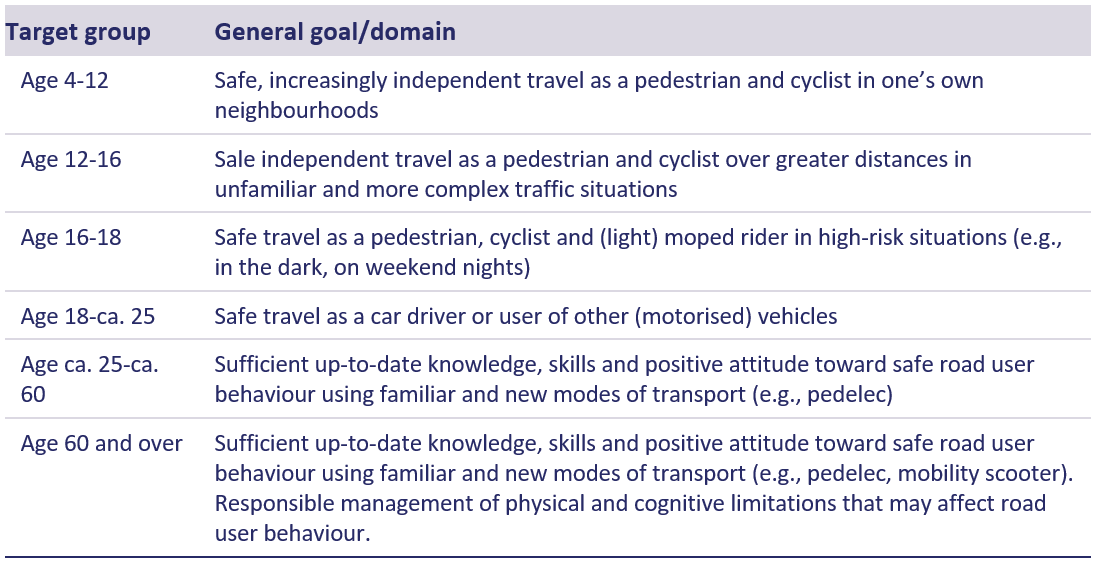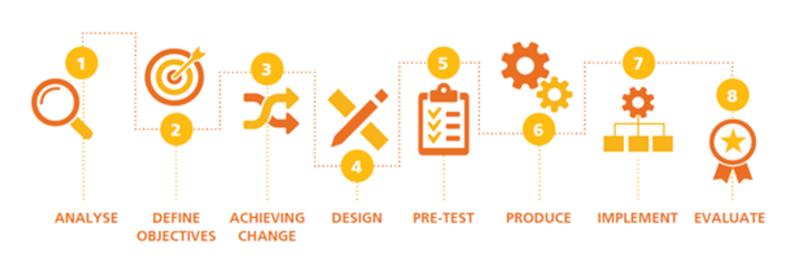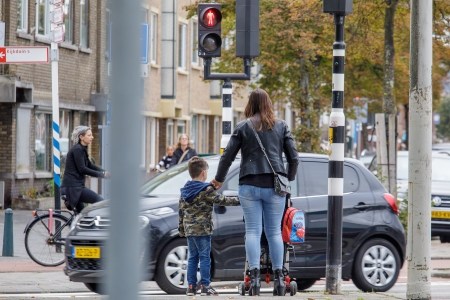Below you will find the list of references that are used in this fact sheet; all sources can be consulted or retrieved. Via Publications you can find more literature on the subject of road safety.
[1]. ETSC (2020). Key principles for traffic safety and mobility education. European Transport Safety Council, Brussels.
[2]. Betuw, A.J.M. van & Vissers, J.A.M.M. (2002). Naar een succesvolle invoering van Permanente Verkeerseducatie: uitgangspunten voor beleid. Gezamenlijke Regionale en Provinciale Organen voor de Verkeersveiligheid.
[3]. Doumen, M.J.A. & Schagen, I.N.L.G. van (2022). Didactische uitgangspunten voor verkeerseducatie. Inventarisatie van relevante leertheorieën en didactische principes [Didactics of traffic education. Inventory of relevant learning theories and didactic principles]. R-2022-17. [Summary in English]. SWOV, Den Haag.
[4]. Hatakka, M., Keskinen, E., Gregersen, N.P., Glad, A., et al. (2002). From control of the vehicle to personal self-control; broadening the perspectives to driver education. In: Transportation Research Part F: Traffic Psychology and Behaviour, vol. 5, nr. 3, p. 201-215.
[5]. Vissers, J.A.M.M., Nägele, R.C., Kooistra, A.B., Betuw, A.J.M. van, et al. (2005). Leerdoelendocument Permanente Verkeerseducatie. In opdracht van Directoraat-Generaal Rijkswaterstaat, Adviesdienst Verkeer en Vervoer AVV. Traffic Test, Veenendaal.
[6]. Rijksoverheid (2023). Welke vakken krijgt mijn kind op de basisschool? Ministerie van Onderwijs, Cultuur en Wetenschap. Accessed on 24-08-2023 at https://www.rijksoverheid.nl/onderwerpen/basisonderwijs/vraag-en-antwoord/welke-vakken-krijgt-een-kind-op-de-basisschool.
[7]. SLO (2016). Karakteristieken en kerndoelen - Onderbouw voortgezet onderwijs. Stichting Leerplanontwikkeling SLO, Enschede.
[8]. CROW (2023). Toolkit Verkeerseducatie. Kennisplatform CROW. Accessed on 24-08-2023 at https://www.crow.nl/kennis/tools-mobiliteit-en-gedrag/toolkit-verkeerseducatie.
[9]. Hoekstra, A.T.G. & Twisk, D.A.M. (2010). De rol van ouders in het informele leerproces van kinderen van 4 tot 12 jaar. Een eerste verkenning [The role of parents in the informal learning process of children in the age group 4 to 12 years-old. A first investigation]. R-2010-19 [Summary in English]. SWOV, Leidschendam.
[10]. Hamann, C.J. & Spears, S. (2019). Parent-adolescent bicycling safety communication and bicycling behavior. In: Accident Analysis & Prevention, vol. 131, p. 350-356.
[11]. TeamAlert (2023). Kruispunt. Accessed on 24-08-2023 at https://teamalert.nl/zakelijk/thema-s/kwetsbare-verkeersdeelnemers/kruispunt/.
[12]. TeamAlert (2023). StreetTalk - Alcohol & Drugs. Accessed on 24-08-2023 at https://teamalert.nl/zakelijk/thema-s/rijden-onder-invloed/streettalk-alcohol-drugs/.
[13]. TeamAlert (2023). Blikveld - Op straat. Accessed on 24-08-2023 at https://teamalert.nl/zakelijk/thema-s/onervaren-verkeersdeelnemers/blikveld-op-straat.
[14]. VVN (2023). Blijf veilig mobiel. Veilig Verkeer Nederland. Accessed on 25-08-2023 at https://vvn.nl/50-plussers.
[15]. Fietsersbond (2023). Fietsersbond Fietsschool. Fietsersbond, Utrecht. Accessed on 23-08-2023 at https://www.fietsersbond.nl/onderweg/fietsschool/.
[16]. Vissers, J., Slinger, W., Hukker, N. & Kluitman, A. (2023). De checklist verkeerseducatie: Tien jaar kwaliteit meten van verkeerseducatieve interventies. In: Tijdschrift Vervoerswetenschap, vol. 59, nr. 2, p. 23-42.
[17]. Mütze, F. (ed.) (2021). The LEARN! Manual for developing and evaluating traffic safety and mobility education activities. European Transport Safety Council ETSC, Brussels.
[18]. Twisk, D.A.M., Vlakveld, W.P., Commandeur, J.J.F., Shope, J.T., et al. (2014). Five road safety education programmes for young adolescent pedestrians and cyclists: A multi-programme evaluation in a field setting. In: Accident Analysis & Prevention, vol. 66, p. 55-61.
[19]. Lehtonen, E., Airaksinen, J., Kanerva, K., Rissanen, A., et al. (2017). Game-based situation awareness training for child and adult cyclists. In: Royal Society Open Science, vol. 4, nr. 3.
[20]. Wijlhuizen, G.J. & Kint, S. van der (2018). Verkeersvaardigheidstraining met virtual reality voor basisschoolleerlingen. Evaluatie van het WegWijs VR-experiment. R-2018-12. SWOV, Den Haag.
[21]. Skjermo, J., Roche-Cerasi, I., Moe, D. & Opland, R. (2022). Evaluation of road safety education program with virtual reality eye tracking. In: SN Computer Science, vol. 2022, nr. 3, Article nr. 149.
[22]. Vankov, D. & Jankovszky, D. (2021). Effects of using headset-delivered virtual reality in road safety research: A systematic review of empirical studies. In: Virtual Rality & Intelligent Hardware, vol. 3, nr. 5, p. 351-368.
[23]. Szczurowski, K. & Smith, M. (2018). “Woodlands” - a virtual reality serious game supporting learning of practical road safety skills. Paper presented at IEEE Games, Entertainment, Media Conference (GEM), Galway, Ireland. August 15-17, 2018.
[24]. Tan, Q.P., Huang, L., Xu, D., Cen, Y., et al. (2022). Serious game for VR road crossing in special needs education. In: Electronics, vol. 11, nr. 16, p. 2568.
[25]. Gounaridou, A., Siamtanidou, E. & Dimoulas, C. (2021). A serious game for mediated education on traffic behavior and safety awareness. In: Education Sciences, vol. 11, nr. 3, p. 127.
[26]. Horswill, M.S., Hill, A., Buckley, L., Kieseker, G., et al. (2022). An online hazard perception training course reduces heavy braking, speeding, and over-revving rates during everyday driving. In: Transportation Research Part F: Traffic Psychology and Behaviour, vol. 87, p. 54-68.
[27]. Duperrex, O., Bunn, F. & Roberts, I. (2002). Safety education of pedestrians for injury prevention: a systematic review of randomised controlled trials. In: British Medical Journal, vol. 324, nr. 7346, p. 1129-1131.
[28]. Twisk, D.A.M., Vlakveld, W.P. & Commandeur, J.J.F. (2007). Wanneer is verkeerseducatie effectief? Systematische evaluatie van educatieprojecten [When is education effective? Systematic evaluation of education projects].. R-2006-28 [Summary in English]. SWOV, Leidschendam.
[29]. Twisk, D.A.M. (2014). Protecting pre-license teens from road risk: Identifying risk-contributing factors and quantifying effects of intervention strategies. Dissertation Maastricht University, Maastricht.
[30]. Gregersen, N.P. & Nolén, S. (1994). Children's road safety and the strategy of voluntary traffic safety clubs. In: Accident Analysis & Prevention, vol. 26, nr. 4, p. 463-470.
[31]. Feenstra, H., Ruiter, R.A. & Kok, G. (2012). Go fast! Reaction time differences between adults and adolescents in evaluating risky traffic situations. In: Journal of Health Psychology, vol. 17, nr. 3, p. 343-349.
[32]. VVN (2016). Doorlopende leerlijn - Verkeerseducatie basisonderwijs. Veilig Verkeer Nederland.
[33]. Sangrar, R., Mun, J., Cammarata, M., Griffith, L.E., et al. (2019). Older driver training programs: A systematic review of evidence aimed at improving behind-the-wheel performance. In: Journal of Safety Research, vol. 71, p. 295-313.
[34]. Davidse, R.J. & Hoekstra, A.T.G. (2010). Evaluatie van de BROEM-cursus nieuwe stijl. Een vragenlijststudie onder oudere automobilisten [Evaluation of the new style BROEM course. A survey among older drivers]. R-2010-6 [Summary in English]. SWOV, Leidschendam.
[35]. Balk, L., Dellas, V., Folkersma Kok, F., Suijlekom, A. van, et al. (2022). Doortrappen - Eindrapportage monitoring en evaluatie. Mulier Instituut, Utrecht.
[36]. Feenstra, H., Ruiter, R.A.C. & Kok, G. (2014). Evaluating traffic informers: Testing the behavioral and social-cognitive effects of an adolescent bicycle safety education program. In: Accident Analysis & Prevention, vol. 73, p. 288-295.
[37]. Cuenen, A., Brijs, K., Brijs, T., Vlierden, K. van, et al. (2016). Effect evaluation of a road safety education program based on victim testimonials in high schools in Belgium. In: Accident Analysis & Prevention, vol. 94, p. 18-27.
[38]. Bojesen, A.B. & Rayce, S.B. (2020). Effectiveness of a school-based road safety educational program for lower secondary school students in Denmark: A cluster-randomized controlled trial. In: Accident Analysis & Prevention, vol. 147, p. 105773.
[39]. Koehler, M., Brockamp, T., Bamberg, S. & Gehlert, T. (2022). Change of risk behaviour in young people - the effectiveness of the trauma prevention programme P.A.R.T.Y. considering the effect of fear appeals and cognitive processes. In: BMC Public Health, vol. 22, nr. 1, p. 595.
[40]. Beanland, V., Goode, N., Salmon, P.M. & Lenné, M.G. (2013). Is there a case for driver training? A review of the efficacy of pre- and post-licence driver training. In: Safety Science, vol. 51, nr. 1, p. 127-137.
[41]. Farmer, C.M. & Wells, J.K. (2015). Crash and citation records of young drivers with skid avoidance training. Insurance Institute for Highway Safety, Arlington.
[42]. Blom, M., Boschman, S.E. & Weijters, G. (2022). Differentiële effectiviteit maatregelen alcohol en verkeer. Cahier 2022-7. Wetenschappelijk Onderzoek- en documentatie Centrum WODC, Den Haag.
[43]. Blom, M., Blokdijk, D. & Weijters, G. (2019). Recidive na maatregelen rijvaardigheid en geschiktheid. Cahier 2019-20. Wetenschappelijk Onderzoek- en Documentatiecentrum WODC, Den Haag.
[44]. Senserrick, T., Ivers, R., Boufous, S., Chen, H.-Y., et al. (2009). Young driver education programs that build resilience have potential to reduce road crashes. In: Pediatrics, vol. 124, nr. 5, p. 1287-1292.
[45]. Senserrick, T., Möller, H., Rogers, K., Cullen, P., et al. (2021). Youth resilience education and 13-year motor vehicle crash risk. In: Pediatrics, vol. 148, nr. 6.
[46]. VeiligheidNL (2023). Fight Your Inner Monkey: stoppen met na-aapgedrag in het verkeer. VeiligheidNL Kenniscentrum letselpreventie. Accessed on 02-10-2023 at https://www.veiligheid.nl/kennisaanbod/lespakket/fight-your-inner-monkey-stoppen-met-na-aapgedrag-het-verkeer.



